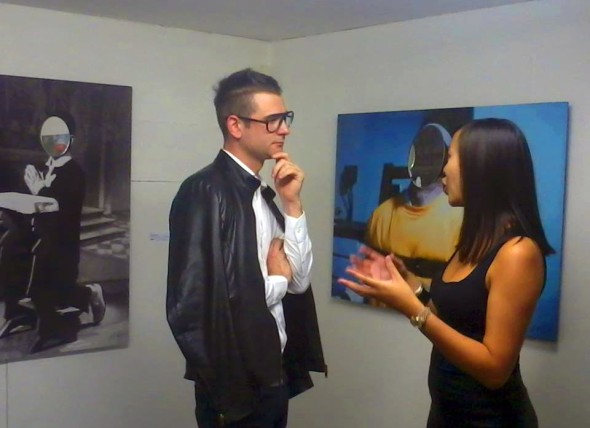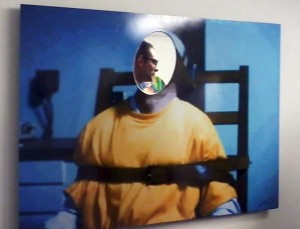The Reflective Venetian: An Interview with Artist Riccardo Schiavon. In an exclusive interview with The Bridge Magazine, contemporary artist, and fashion, interior and environmental designer, Riccardo Schiavon, talks about his latest exhibition at the Brick Lane Gallery in London, and the future of his art.
20 September 2013
9,550 views
No Comment
Riccardo Schiavon is one of an upcoming crop of young successful contemporary artists who have graduated from university straight into the gallery circuit, where he has been exhibiting his challenging and avant-garde art widely.

WITHIN & WITHOUT– Contemporary Portraits
Riccardo Schiavon and Tessa Yee (Manager of the Brick Lane Gallery)
The Bridge MAG. image
An alumnus of Politecnico di Milano, the 27 year old, Venetian-born Schiavon is among ten UK-based, international artists short-listed to represent their work at The Brick Lane Gallery in London, the other nine being Czar Catstick, Jo Gillespie, Micheal Hayter, Nikki Cutting, Lee Trewick, Paul Dickinson, Phaedra Peer, Stefan Esanu, Stuart Lee.
The ten young artists have been left with the challenge of showcasing the full scope of their creativity, using their talents in myriad mediums, including oil and acrylic painting, illustration, digital and other art forms, to produce and exhibit portraits composed around the theme of the human personality behind the mask of the face.
An official press release issued by the Brick Lane Gallery regarding the show states: ‘Portraiture could be considered as the most relatable and touching subject matter to tackle in art. Artists are faced with the challenges of not only capturing the human face, but also the personality and story behind it.
PORTRAITS NOW aims to compile a range of works by upcoming and established UK-based and international artists who explore the subject of portraiture from unique angles’.
The actual definition of ‘contemporary artists’ is slightly broader than one might expect: it incorporates all artists whose peak of activity falls within a broad remit of the past four decades, from the Seventies to today.
When the eminent International Journalist, Film /Arts and Screen Trade Media UK Paul D.
Dasilva took us in the Brick Lane gallery basement, one of the pieces that particularly caught the Bridge Magazine’s attention at the Brick Lane private view on Wednesday 14th August 2013, was Schiavon’s damn people, displayed in the Brick Lane gallery basement, which uses the iconic image of Ted Bundy.
When Schiavon came up to us to ask if we had ever heard of Ted Bundy, we of course affirmed that we did only too well: Bundy’s name has been cited frequently in The Bridge Magazine’s ‘True Crimes and Prevention News’.
Schiavon employs a variety of uncanny techniques to draw in the viewer of his work. For instance, in damn people, the viewers find themselves figuratively put in the place of Ted Bundy as he is sat in the electric chair –a disturbing juxtaposition which forces them to empathise with the position of someone demonstrably bereft of any empathy (his having been, presumably, psychopathic).
When asked how he came to compose damn people, Schiavon replied: “It is a screen shot taken from the same-titled 2002 film. The digital image was processed and printed by myself on Dibond, which I then painted over using a gloss”.
This controversial piece works at a deeply psychological level, and challenges viewers’ sensitivities in a way which contrasts starkly against the proverbial quotidian non-sequiturs of much contemporary conceptual art (e.g. such as that of Tracy Emin and the ‘Stuckists’).
The particular dialectical tilt of Schiavon’s damn people is in his ingenious replacement of Bundy’s face with a mirror:
-So that it is not Bundy’s, but the viewer’s face, that is reflected back from the piece; thus intimating that all of us, given the right –or rather ‘wrong’– set of circumstances (in terms of upbringing and psychological and behavioural experience, development, and maladjustment), have the potential for evil. Schiavon’s literal use of a mirror-like reflection of the viewer’s face superimposed over Bundy’s is also, thus, a psychologically figurative one-.
But Schiavon masterfully choreographs his art works to be as accessible as possible, so that they are every bit as inclusive as they are profound. There is no need to be an ‘art expert’ to grasp the very primal depths of his oeuvre. Schiavon’s art is highly evocative, both aesthetically and emotionally: it expresses something very clearly, and uncompromisingly, and makes us have a strong reaction to it. His art is also ‘figurative’ in the strictly artistic sense of the term: he presents us with easily discernable human figures, faces, objects, and scenes, rather than representing feelings or ideas abstractly as in more expressionistic or symbolic art.
The metaphorically reflective-surface face of damn people reminds us of the existentialist French philosopher Jean Paul Sartre (1905-1980) and his theories on self-consciousness, which included tropes such as: ‘the other me is an essential mediator between me and myself’.
Sartre argued that self-consciousness is possible when one is compelled to self-awareness with the reflective activity forced upon him by the ‘look’ of the other. In this sense, then, it could be argued that Schiavon’s use of a mirror instead of face in this picture actually symbolises the absence –rather than emphasis– of the viewer’s own awareness. Whatever the interpretation one makes, the key dialectic of damn people would appear to be that of the essentialness of ‘reflection’, literally and mentally, if one is to cultivate full self-awareness.
Others might equally think of the psychological theories of Sigmund Freud in relation to this sublime work; or, perhaps more appositely, those of Carl Jung, particularly his theory of human ‘archetypes’ and the theory of ‘scapegoating’, or what the Swiss psychiatrist termed ‘shadow projecting’ (attributing blame for a personal moral fault to an external agent, i.e., another person).
By inviting the viewer to gain a disturbing sense of human solidarity with such a grotesque psychopathology as Bundy’s, Schiavon is raising his art to the most challenging of levels. It is hard to imagine a more graphically philosophical way to reflect the theme of the Brick Lane exhibition.
It could, further, be argued, that part of the artist’s ambition here is to neutralise any dormant ‘evil’ side to the viewer, by reflecting back at them the latent potential for brutality in all of us, thus forcing a reflexive introspection, followed by a macro-conscious awareness of the potential for such ‘evil’ behaviours in wider society.
On 10th September 2013, when asked by The Bridge Magazine whether the similarly challenging WITHIN & WITHOUT–Contemporary Portraits exhibition had been a success, Tessa Yee, Damn People by R. Schiavon. , replied:
“It was the first group show that the Brick Lane Gallery has hosted that focussed purely on the subject matter of portraiture. We were really happy with the outstanding quality and variety of works on display in this show, and found that audiences responded really well to the exhibition in general…
The Bridge Magazine wasn’t surprised when the Venetian artist explained to us on 14th August 2013 that his work has been influenced by a philosopher:…
Feel free to follow the interview below to learn more about the Italian artist:
Follow the links below to read more:
1)
https://www.lulu.com/en/gb/shop/rachel-tcheungna/arts-and-culture-global-news-that-never-fades-the-bridge-magazine-book-from-britains-news-to-world-exclusives/paperback/product-q764zz.html?page=1&pageSize=4
2)
https://www.lulu.com/en/gb/shop/rachel-tcheungna/global-news-that-never-fades-from-britains-news-to-world-exclusives/paperback/product-ennmdm.html?page=1&pageSize=4
Rachel Tcheungna, Author, Writer of
The Bridge Books and
The Bridge Magazine Editor.


